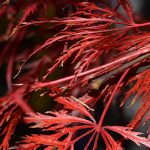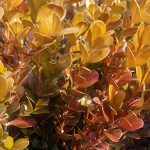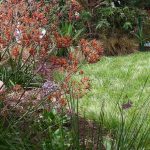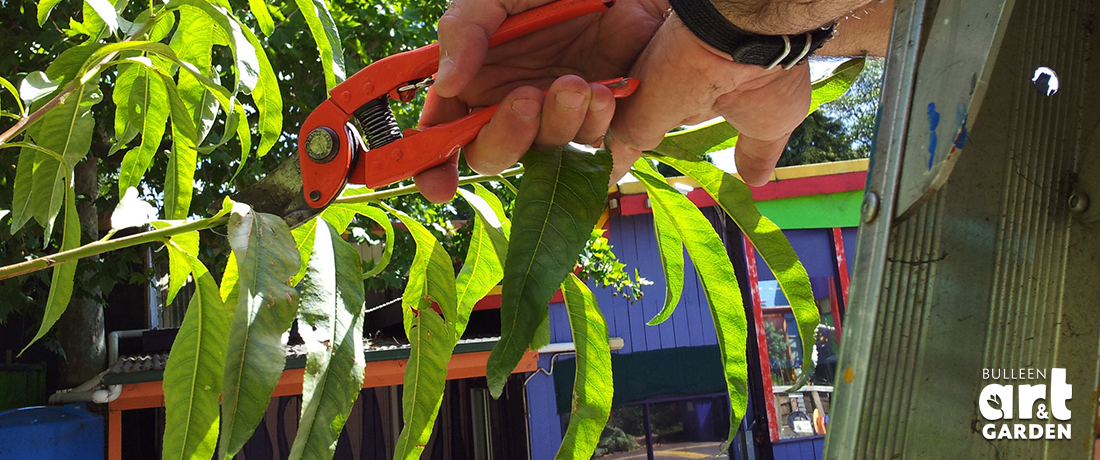
The traditional time to prune your deciduous fruit trees is in late winter while they’re dormant, before the buds open. Pruning is basically the removal of selected parts of a tree to control its growth to suit our purposes.
- Pruning carried out in the first three years to create the trees shape is called formative (framework) pruning.
- Once the tree has grown into the desired shape, we keep it that way with maintenance (detail) pruning.
- If a mature tree needs reshaping because it has grown too large or has been neglected, we can restore the shape and fruiting wood with renovation pruning.
Fruit trees don’t need pruning to bear fruit, but, if we don’t prune, the tree can become too large and difficult to manage. Unmanaged trees eventually become overcrowded with non-productive wood, and tend to produce every second year (biennial cropping). When they do fruit they are likely to produce lots of very small fruit that are too high to reach.
Why we prune
- 1. To maintain the tree in a specific shape, such as a vase, central leader, or espalier form.
- 2. To limit size, as low trees are easier to prune, harvest, spray and net.
- 3. To allow light to penetrate into the canopy, which reduces fungal diseases, allows for more even fruit ripening, and reduces shading of lower branches (which helps keep lower fruit buds and fruiting spurs alive).
- 4. To limit fruiting, as pruning thins out the fruit, producing larger fruit and consistent cropping year to year, rather than lots of little fruit every second year.
- 5. To remove unproductive wood with few leaf & flower buds and replace it with more productive new growth.
- 6. To renovate the tree to remove dead, diseased or damaged branches, to renew fruiting wood, to shorten long branches so they don’t break from weight of fruit, and to restore the shape of overgrown, neglected trees.
Pruning deciduous trees in the winter months encourages regrowth, which is desirable for formative pruning, when we want to shape a young tree, or for renovation pruning, where we want to change the shape of a mature tree.
Summer pruning is preferred to maintain a tree’s shape and keep the size of the tree down, though winter pruning is commonly used for this purpose too.
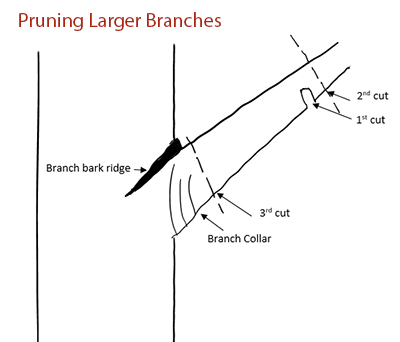
Understanding what to prune
Before beginning to prune a tree, it’s important to understand how different parts of a tree grow and what happens when we prune them.
- Upright growth is generally vegetative (non-fruiting green leafy growth) and vigorous.
- Horizontal branches generally favour the formation of fruiting buds and are less vigorous.
We can prune (shorten) branches to create more of the growth we require:
- Pruning a vertical branch creates vegetative growth and branching.
- Pruning a horizontal branch renews fruiting wood and thins excessive fruit.
We can also thin out (remove) branches to improve fruiting:
- Thinning vertical branches opens the tree to more light for more even fruit ripening.
- Thinning horizontal branches removes fruit, and has the same effect as fruit thinning (larger fruit and consistent fruiting every year).
Note – Horizontal branches left uncut will bear earlier and heavier crops.
Branches bent at angles of 45-60 degrees achieve a balance between vertical and horizontal growth, and can hold more weight of fruit without breaking.
If the angles between branches are too narrow, they can be spread out to the correct angle using a ‘spreader’ or weighted down by tying the branches down with string to bricks or stakes in the ground.
Now that we’ve looked at what to cut, it’s important to know how to make proper pruning cuts
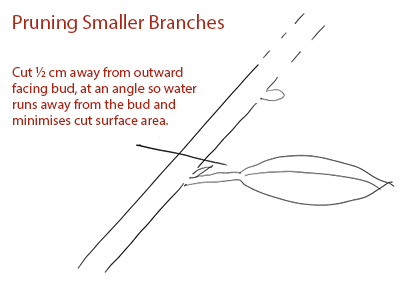
How to prune
New growth will occur near the area of the pruning cut. The more you cut off, the more regrowth will be produced. This is counterintuitive, because the way to make a branch grow more is to prune harder, to cut off more!
When pruning, always prune ½ cm above an outward facing bud, at an angle so water runs away from bud.
When removing branches smaller than about 2cm thick, use bypass secateurs to cut off the branch at its base without damaging the collar.
(The branch collar is a distinctive bulge at the base of the branch, where it connects to the trunk – even if you cannot see it, it is still there and should not be damaged). DO NOT CUT BRANCHES FLUSH WITH THE TRUNK!
Loppers and pruning saws can be used for pruning thicker branches.

When removing large branches with a pruning saw, to prevent tearing off the bark and damaging the tree as it comes off, use a three-cut method of pruning. Don’t cut the branch flush with the trunk or parent limb, be sure to leave a collar (a short stub). (see diagram).
To prevent the spread of diseases between trees, clean pruning equipment with a mixture of 75% methylated spirits, 25% water in a spray bottle and wipe clean between trees
Do not apply paints or sealants to pruning cuts. Allow the cuts to dry in open air and heal naturally. Research findings show that there is no benefit to the tree and the practice can even encourage disease. The main use of pruning sealants is cosmetic to disguise pruning cuts.
How to prune your fruit tree
If your fruit tree already has an established shape, then prune to maintain that shape.
Before pruning for shape or to renew fruiting wood, the following pruning needs to be carried out first.
- 1. Remove all dead, broken and diseased branches to eliminate entry points for pests and diseases and prevent further spread of disease.
- 2. Remove the weakest of crossing branches and any competing branches growing straight up into the tree, to prevent them rubbing and damaging each other, as the wounds create entry points for diseases.
- 3. Remove any suckers & water sprouts (fast growing vertical shoots growing from the roots and branches respectively) as they reduce the vigour of tree.
- 4. Remove branches bending downward beyond 90 degrees, cut off the part hanging down, as they will lose vigour and produce only a few small fruit)
Fruit trees are commonly pruned as a central leader or vase shape.
The central leader: form is commonly used on apples and pears, though these can also be pruned as a vase shape.
The vase shape has an open centre, and is the form used for peaches, nectarines, plums and apricots – as some of these branch too heavily to maintain a central leader form. The vase shape is a very popular form for backyard fruit trees.
With pruning, the aim is to maintain the existing form of the tree, or to renovate it to return it back to its original form.
To prune most fruit trees, simply prune new growth by half to an outward facing bud to renew the fruiting wood.
There are some exceptions to this rule, as different types of fruit trees flower and fruit on wood of a particular age and sometimes on certain parts of the branches. Listed below are the detailed pruning instructions for the most common types of fruit trees and a few notable exceptions.
Pruning Stone Fruit
Winter Pruning Japanese Plums, Peaches and Nectarines; Spring or late autumn pruning apricots
These all bear fruit on one year old wood (new wood produced the previous summer). NOTE – Do not winter prune apricots! Apricots are prone to bacterial gummosis and should only be pruned in spring or late autumn on a dry and preferably windy day to prevent infection entering the pruning cuts.
- 1. Cut all inward-growing branches to open up the centres of the trees.
- 2. Then prune back all current season’s growth by about half.
Summer Pruning Dwarf Peach Trees
Some people recommend pruning dwarf peach trees in summer. This way you can easily select growth for next season’s crop. When you look at your tree, there will be three types of wood; Last years fruiting wood, this years fruiting wood (has fruit on it) and next years fruiting wood (growth that is fresh, and has no fruit on it). Peaches grow on the lateral growth made in the previous season, so leaving alone branches bearing fruit this season, prune to remove the previously fruited old wood, and carefully thin and space out the new seasons fruiting wood which will bear fruit next year.
Winter Pruning Apples, Pears and European Plums
Apples, pears and European plum trees are pruned differently. These fruit on spurs formed on two year and older wood (old wood formed 2 or more summers ago).
Apples
- Shorten old fruiting laterals (side branches and twigs) by half.
- Remove weakened laterals to encourage the more vigorous laterals to produce fruiting spurs.
- Thin out excess regrowth to allow better light penetration.
- Remove old, non-productive fruit spurs and twigs (ones that have fruited for more than 3-4 years).and thin out crowded fruit spurs.
Pears
- Fruit is produced on long-lived spurs on old laterals.
- Shorten old fruiting laterals (side branches and twigs) by half.
- Thin out old and crowded fruit spurs.
- Remove weakened laterals to encourage the more vigorous laterals to produce fruiting spurs
European Plums
- Fruit is produced on long-lived spurs on 2 year old laterals.
- Shorten long laterals (side branches and twigs) by half, or to 20 cm if they are very long, to renew the fruiting spurs.
- Short laterals under 25cm, particularly if they are behind fruiting spurs, can be left unpruned.
- Remove any weak or unproductive fruiting spurs.
Pruning Other Fruit Trees
Winter Pruning Quinces
- Quinces fruit on current season’s growth from a spur-like structure that carries both fruit and wood buds, so do not prune after growth starts in spring.
- Shorten old fruiting laterals (side branches and twigs) by half.
- Prune out very long shoots that are crowding out the canopy.
Winter Pruning Cherries
- Require little pruning from year to year. The first and second years growth will form the framework of the tree.
- Shortening the main branches by half to two thirds to an outward facing bud is all that is required.
- Fruiting spurs will develop along the branches, from which the fruit is borne. Prune out any broken branches, or those that cross over other branches.
- Old, unproductive spurs may be pruned out and new spurs created by pruning back a new shoot to the main lateral.
Winter Pruning Figs
- Figs can be trained as espaliers, open vase and bush shapes.
- Some figs produce two crops a year in temperate and sub-tropical climates.
- The first crop (breba crop) is produced in summer on the tips of the previous season’s growth.
- The second or main crop is borne at the base of the current season’s growth.
- Prune some of the longer previous season’s growth to promote new growth for the main crop, while leaving some of the shorter branches unpruned to carry the breba crop.
Winter Pruning Persimmons
- Persimmons fruit from new growth that arises from the last few buds of the previous season’s growth
- Don’t shorten all the previous season’s new growth as this will remove all the fruiting wood!
- Leave some new growth unpruned and prune other growth back to a few buds to produce fruiting wood in two season’s time.
Winter Pruning Pomegranates
- Pomegranates fruit on short shoots or spurs near the ends of branches which remain productive for 3-4 years, after that cut to a younger side branch to renew fruiting wood.
- If you cut the ends of all branches, no fruit will be produced!
- Pomegranates sucker heavily, so remove all suckers (shoots coming up from the roots) as they reduce the vigour of the tree.
Pruning Overgrown Trees
If trees have become overgrown, renovation pruning can be used to reduce the size of the tree gradually.
The best way to reduce the canopy size of a fruit tree is to remove a major limb or two in late winter, which will encourage regrowth to create replacement branches. The new shoots can then be pruned to the correct size and maintained that way.
The simple rule to follow is do not remove any more than one third of the canopy during any one year. Using this system, the whole canopy can be renewed over a three year period.
Over-pruning can stress and weaken the tree, so it’s best to do major renovation pruning gradually, and to keep up with the pruning each year so trees don’t get too large!
Suturing
To encourage branches to shoot below another branch without pruning off any of the above growth, a small nick can be made through the bark just above a bud. This is called suturing and is a useful technique to encourage branching where there is a gap in the canopy.

